|
|

|
Porsche, and the Porsche crest are registered trademarks of Dr. Ing. h.c. F. Porsche AG.
This site is not affiliated with Porsche in any way. Its only purpose is to provide an online forum for car enthusiasts. All other trademarks are property of their respective owners. |
|
|
| Jeff Hail |
 Oct 1 2007, 11:35 PM Oct 1 2007, 11:35 PM
Post
#1
|
|
Senior Member    Group: Members Posts: 1,141 Joined: 3-May 07 From: LA/ CA Member No.: 7,712 |
Bringing Out The Dead.....or how to restore a rusty 914 and convert it to a street/track car when I have time after dealing with everyone elses stuff.
My background is collision and restoration (day job) of high end automobiles for 28 years in addition to race fabrication. I jumped the fence and left that industry to pursue pretty much the same thing except on the paperwork end which is really boring and thankless. (another day job) I look at rust like a diamond in the rough. Rust is afraid of me because it know's it cannot live in my world. Metal becomes submissive because I have confidence in my metal working talents. I will add to this post as work progress's. I hope my years of experience can help others as I add. I believe there is a right way to repair a car and wrong way. I metal finish because in the end its cleaner, lighter and stronger. I was taught old school techniques with new school technology. A great combination. I also believe in doing a job once correctly using the highest quality materials and proper tools. Many ways to skin a cat I say. If you hold it by the tail it can still bite! Good advice to follow: Take measurements of the door openings and targa bar to windshield header. Cross measure then do it again to confirm. Recheck your measurements against the factory figures. Make a couple of adjustable braces for each side that attach from the upper seat belt anchors to the door hinges. I recommend cross braces also right to left. These can be made from rod or tube and turnbuckles for cheap. Racer Chris has some really nice ones with rod ends. Support the car from below equally on both sides of the undercarriage and front and rear. I do not believe jack stands can hold the proper tolerances at 4 points. It takes a minimum of 6 and preferably 8. These are all easy to do and are essential to a square and level chassis. Not everyone can afford a Cellete bench or hourly frame time at a shop for these type of do it yourself repairs. Impovisation can be done correctly and for a lot less money. Make sure your floor or platform is level. Keep in mind that tolerances for the 914 were 7-9mm from the factory so anything you can do to make it better is worth it. 7mm by today’s standards is huge. 9mm is a Grand Canyon. Anything you can do to tighten the tolerances will provide a better end product. Exterior panels were fit with the adjust and weld method and are only a skin. My 914 had measurements all over the place on the front end and the rust issues were all in the rear that needed correction. Car was never in any collisions. 90% of the measurements were factory assembly tolerances. Porsche's aint perfect. I made my own dedicated bench for 911's and 914's. By some stroke of luck I ended up with a 1 mm variance in height (datum) and 2mm in length and width is zero with my own fixtures. This has been substantiated with endless anal cross measuring and factory manuals. I used a steel front suspension cross member as a front body holding fixture. I went through 4 before I found an acceptable one. The first 3 were so far off factory tolerances (4-6 mm out of square) I rejected them before I found a good one. My bench is not for pulling. It was designed for assembly and replacement of structural parts. It will support 3,000 pounds. $350 worth of steel and another $175 in industrial castors was worth it considering its use. A stripped 914 shell is a feather and easy to roll around. When you cut and replace structural parts recheck your measurements. Control points change when you remove, replace and weld in new parts. They are easily controlled with patience. If it does not come out perfect do not lose sleep. Remember tolerance and variance was not perfect from the factory. If you have a control point locating hole that is 14 mm a dowel or pin of 9-10mm was used during birth. That is why suspension systems are adjustable for variance and wear. You will also find center indexing points on the front and rear of the body. Easy tools to use are plumb lines, tape measures and levels if you do not have access to high end measuring equipment. You can locate and make symmetrical measurements throughout repairs. If you have one side that is undamaged or not rusted use that side as a starting point for measurements. Use panel gaps as a visual indicator during repairs and welding. 3 important factors- height, length and width. If you are me then there are 4 (Z axis) and that one will make you lose sleep! Some pics of the beggining: A back east 914 comes to California. Attached image(s) 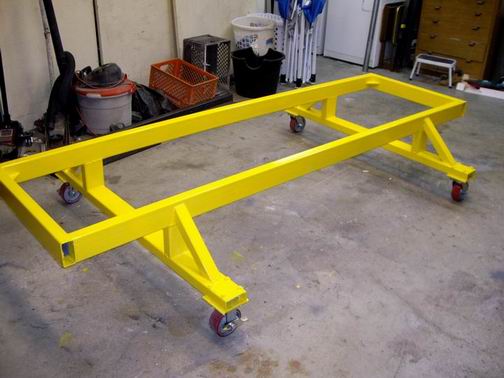 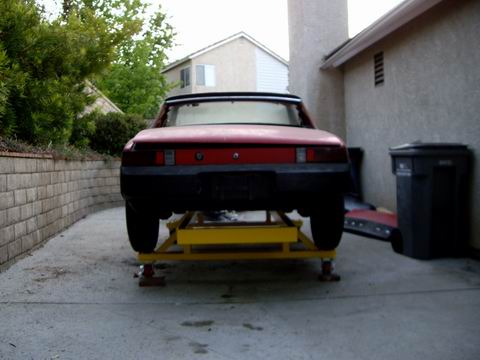 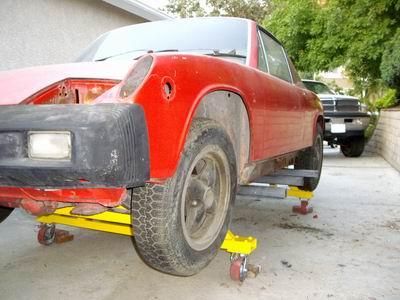 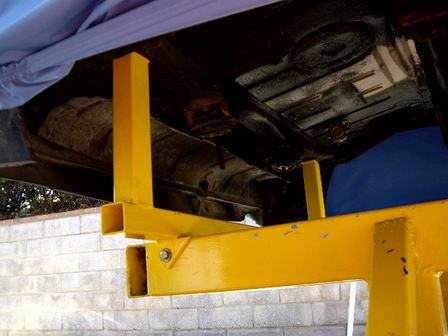
|
  |
Replies
| Jeff Hail |
 Oct 26 2007, 11:50 PM Oct 26 2007, 11:50 PM
Post
#2
|
|
Senior Member    Group: Members Posts: 1,141 Joined: 3-May 07 From: LA/ CA Member No.: 7,712 |
type11969 has a few questions regarding Roloc disc's
3M is not the only one who makes the threaded plastic hub abrasive discs that fits the standard Roloc arbors/adaptors. I use a few off brands as well. The ones I use more of are for clutch and brake disc conditioning. Same fine grits available as 3M for 1/5 the price. I find them in bags of 100 for about $20.00 One of my local suppliers retired so I now have to order them from an internet supplier ( Autobody Tool Mart) which is a great supplier of body needs. You can find them at www.autobodytoolmart.com or 1-800-382-1200 The Rolocs disc's and arbors are pictured below. The arbor adaptors are the same for small sanding disc's so everything is a quick change universal fit. These are the standard of the autobody industry. Very convenient and long lasting. The part # for the (3M) arbor/ backing pad's are: 1 inch- 05538 2 inch- 05539 3 inch- 05540 These are 1/4 inch shanks. I included a picture of the die grinders they fit. The disc's are available in both sanding discs and conditioning disc's. Sanding discs are available in 24,36,50 grits and are round sand paper disc's. (The Green Corp's- 3M) Conditioning disc's come in fine , medium and course. These are the one's I prefer as they last long and do not thin metal. They smooth and clean the surface. They look like old dirty panty hose spun with resin. The fine grit doesn't leave sand scratches and requires almost no finish work. The big nasty looking black disc's on the right are 3M Clean and Strip disc's. Two kinds are available. Roloc standard and the big ones as pictured. These take a different arbor which is 1/4 inch that fits any die or angle grinder. The same arbor for these big disc's would be used on cut-off wheels or weld grinding disc's. These are for aggressive coating removal. If you are stripping large area's I would use Aircraft Stripper. Work smart not hard. If you are stripping thin gauge exterior body panels (fend's , door's qtr's, hood's etc) you do not want to apply heat with rotating abrasives. A lo speed DA is ok but still a lot of work. Heat warp's. Use stripper. If you are stripping longs, trunks and other area's that may have thicker metal and are not normally visible on the exterior then alternative abrasives such as Clean & Strip disc's are fast to get down to bare metal. Attached image(s) 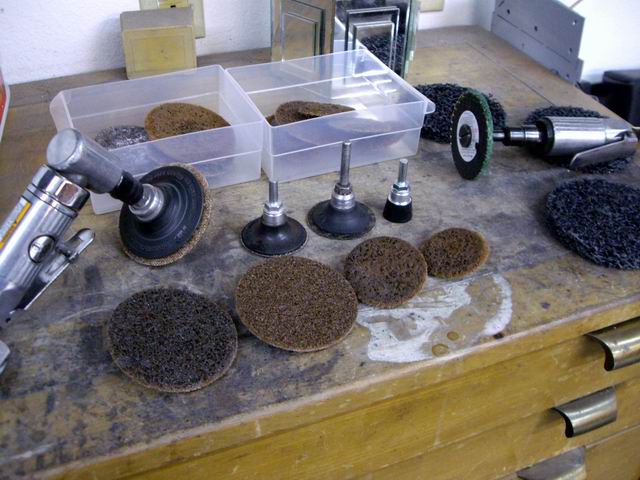 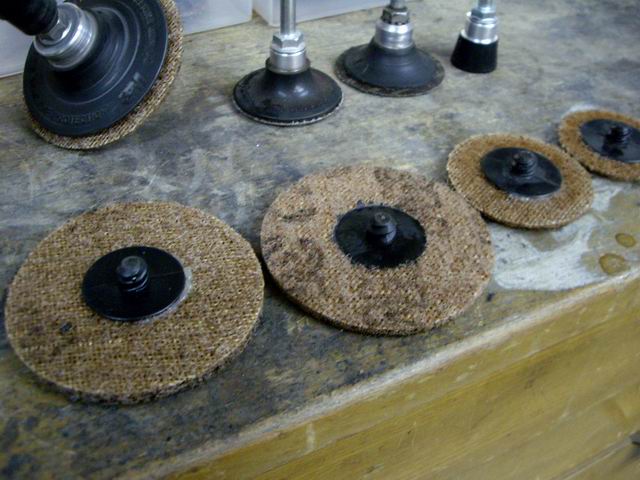 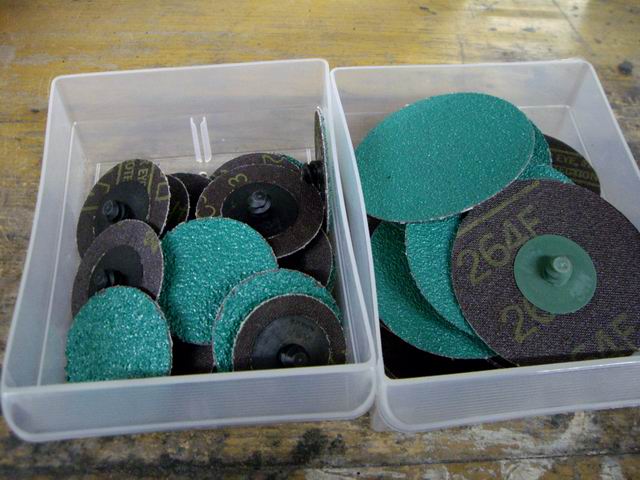
|
Posts in this topic
 Jeff Hail Bringing out the dead Oct 1 2007, 11:35 PM
Jeff Hail Bringing out the dead Oct 1 2007, 11:35 PM
 Jeff Hail Contd Oct 1 2007, 11:37 PM
Jeff Hail Contd Oct 1 2007, 11:37 PM

 Jeff Hail
Contd
Rear floor replacement. An yes the RD flo... Oct 1 2007, 11:41 PM
Jeff Hail
Contd
Rear floor replacement. An yes the RD flo... Oct 1 2007, 11:41 PM
 Eric_Shea Wow :o
:wttc:
This'll be a fun one to watch. Oct 1 2007, 11:43 PM
Eric_Shea Wow :o
:wttc:
This'll be a fun one to watch. Oct 1 2007, 11:43 PM

 Jeff Hail
Wow :o
:wttc:
This'll be a fun one to watch... Oct 1 2007, 11:47 PM
Jeff Hail
Wow :o
:wttc:
This'll be a fun one to watch... Oct 1 2007, 11:47 PM

 Jeff Hail Interior stripped.
Odometer? DMV say its for real ... Oct 1 2007, 11:57 PM
Jeff Hail Interior stripped.
Odometer? DMV say its for real ... Oct 1 2007, 11:57 PM

 Jeff Hail Moving along into the rocker and longs. This was h... Oct 2 2007, 12:08 AM
Jeff Hail Moving along into the rocker and longs. This was h... Oct 2 2007, 12:08 AM

 Jeff Hail Cut out the rusted outer. Actually only the rear 1... Oct 2 2007, 12:17 AM
Jeff Hail Cut out the rusted outer. Actually only the rear 1... Oct 2 2007, 12:17 AM

 Jeff Hail Floor metal finished and primed. No filler.
I did ... Oct 2 2007, 12:54 AM
Jeff Hail Floor metal finished and primed. No filler.
I did ... Oct 2 2007, 12:54 AM
 jd74914 Nice work, I can't wait to see more . . . and
... Oct 1 2007, 11:52 PM
jd74914 Nice work, I can't wait to see more . . . and
... Oct 1 2007, 11:52 PM
 KELTY360 :wttc:
Are you the Jeff Hail of the Mulholland ... Oct 2 2007, 12:42 AM
KELTY360 :wttc:
Are you the Jeff Hail of the Mulholland ... Oct 2 2007, 12:42 AM

 Jeff Hail
:wttc:
Are you the Jeff Hail of the Mulholland... Oct 2 2007, 01:00 AM
Jeff Hail
:wttc:
Are you the Jeff Hail of the Mulholland... Oct 2 2007, 01:00 AM
 Twystd1 Were you part of the Mulholland crew back in the d... Oct 2 2007, 12:48 AM
Twystd1 Were you part of the Mulholland crew back in the d... Oct 2 2007, 12:48 AM

 Jeff Hail
Were you part of the Mulholland crew back in the ... Oct 2 2007, 01:19 AM
Jeff Hail
Were you part of the Mulholland crew back in the ... Oct 2 2007, 01:19 AM
 Lou W :wttc: Keep the pctures coming. :) Oct 2 2007, 03:07 AM
Lou W :wttc: Keep the pctures coming. :) Oct 2 2007, 03:07 AM
 Justin Fischer :wttc: Wow, that was some introduction. Keep th... Oct 2 2007, 08:18 AM
Justin Fischer :wttc: Wow, that was some introduction. Keep th... Oct 2 2007, 08:18 AM
 SGB shhhh.
Artist at work.
Thats really impressive. Oct 2 2007, 08:27 AM
SGB shhhh.
Artist at work.
Thats really impressive. Oct 2 2007, 08:27 AM
 pin31 Very cool !!!
Someone should write a ... Oct 2 2007, 10:11 AM
pin31 Very cool !!!
Someone should write a ... Oct 2 2007, 10:11 AM
 Jeff Hail This weeks installment of Bringing out the dead
A... Oct 6 2007, 09:22 PM
Jeff Hail This weeks installment of Bringing out the dead
A... Oct 6 2007, 09:22 PM
 Jeff Hail Some great tools to have are the Astro Scraper. It... Oct 6 2007, 09:32 PM
Jeff Hail Some great tools to have are the Astro Scraper. It... Oct 6 2007, 09:32 PM
 sixnotfour I am in shock that some one in CA would take on th... Oct 6 2007, 09:36 PM
sixnotfour I am in shock that some one in CA would take on th... Oct 6 2007, 09:36 PM

 Jeff Hail
I am in shock that some one in CA would take on t... Oct 6 2007, 11:00 PM
Jeff Hail
I am in shock that some one in CA would take on t... Oct 6 2007, 11:00 PM
 Jeff Hail Seam sealer stripped off the inner firewall with t... Oct 6 2007, 09:50 PM
Jeff Hail Seam sealer stripped off the inner firewall with t... Oct 6 2007, 09:50 PM
 Jeff Hail You gotta have bars. Keep those gaps in check when... Oct 7 2007, 12:06 AM
Jeff Hail You gotta have bars. Keep those gaps in check when... Oct 7 2007, 12:06 AM
 Jeff Hail This is an original Coppertone car that was re-pai... Oct 7 2007, 12:13 AM
Jeff Hail This is an original Coppertone car that was re-pai... Oct 7 2007, 12:13 AM
 stateofidleness even if you're just cutting out small patches ... Oct 7 2007, 01:11 AM
stateofidleness even if you're just cutting out small patches ... Oct 7 2007, 01:11 AM

 Jeff Hail
even if you're just cutting out small patches... Oct 7 2007, 01:41 AM
Jeff Hail
even if you're just cutting out small patches... Oct 7 2007, 01:41 AM
 watsonrx13 Very nice photo-documentary on the restoration of ... Oct 7 2007, 07:30 AM
watsonrx13 Very nice photo-documentary on the restoration of ... Oct 7 2007, 07:30 AM

 Jeff Hail
Very nice photo-documentary on the restoration of... Oct 7 2007, 02:52 PM
Jeff Hail
Very nice photo-documentary on the restoration of... Oct 7 2007, 02:52 PM
 KELTY360 That lower firewall is serious sheetmetal porn. ... Oct 7 2007, 10:07 AM
KELTY360 That lower firewall is serious sheetmetal porn. ... Oct 7 2007, 10:07 AM
 Jeff Hail The lower outer firewall is out. I didn't even... Oct 7 2007, 07:49 PM
Jeff Hail The lower outer firewall is out. I didn't even... Oct 7 2007, 07:49 PM
 Jeff Hail Didn't get much done with the car this week. B... Oct 14 2007, 09:08 PM
Jeff Hail Didn't get much done with the car this week. B... Oct 14 2007, 09:08 PM
 Jeff Hail I could have repaired and sectioned the right inne... Oct 14 2007, 09:18 PM
Jeff Hail I could have repaired and sectioned the right inne... Oct 14 2007, 09:18 PM
 Jeff Hail The outer wheelhouse metal is sound. I was surpise... Oct 14 2007, 09:35 PM
Jeff Hail The outer wheelhouse metal is sound. I was surpise... Oct 14 2007, 09:35 PM
 type11969 Jeff- nice work, just figured out that you were th... Oct 14 2007, 09:50 PM
type11969 Jeff- nice work, just figured out that you were th... Oct 14 2007, 09:50 PM

 Jeff Hail
Jeff- nice work, just figured out that you were t... Oct 14 2007, 11:11 PM
Jeff Hail
Jeff- nice work, just figured out that you were t... Oct 14 2007, 11:11 PM

 type11969 Jeff-
Thanks for the info. I've tried us... Oct 15 2007, 08:11 AM
type11969 Jeff-
Thanks for the info. I've tried us... Oct 15 2007, 08:11 AM
 tdgray Great work Jeff.... great when you get to say... ... Oct 15 2007, 07:56 AM
tdgray Great work Jeff.... great when you get to say... ... Oct 15 2007, 07:56 AM
 Jeff Hail A couple of hours to play today.
Cut the old inne... Oct 16 2007, 09:19 PM
Jeff Hail A couple of hours to play today.
Cut the old inne... Oct 16 2007, 09:19 PM
 Jeff Hail Rust is a crafty beast. If you can see rust you ar... Oct 16 2007, 09:30 PM
Jeff Hail Rust is a crafty beast. If you can see rust you ar... Oct 16 2007, 09:30 PM
 Jeff Hail I mentioned the other day double walled panels. Th... Oct 16 2007, 09:48 PM
Jeff Hail I mentioned the other day double walled panels. Th... Oct 16 2007, 09:48 PM
 Jeff Hail A mock up shot from underneath. Oct 16 2007, 10:01 PM
Jeff Hail A mock up shot from underneath. Oct 16 2007, 10:01 PM
 Jeff Hail An important note I would like to mention: "I... Oct 16 2007, 10:35 PM
Jeff Hail An important note I would like to mention: "I... Oct 16 2007, 10:35 PM
 SirAndy very nice! you have some skillz, sir ... :wor... Oct 16 2007, 10:36 PM
SirAndy very nice! you have some skillz, sir ... :wor... Oct 16 2007, 10:36 PM
 Jeff Hail We always can use tutorials with pics. Here is a c... Oct 16 2007, 11:08 PM
Jeff Hail We always can use tutorials with pics. Here is a c... Oct 16 2007, 11:08 PM
 type11969 Jeff-
Seriously nice work, thanks for the in... Oct 17 2007, 09:13 AM
type11969 Jeff-
Seriously nice work, thanks for the in... Oct 17 2007, 09:13 AM
 Jeff Hail Don't you love it when you are making a new po... Oct 18 2007, 09:34 PM
Jeff Hail Don't you love it when you are making a new po... Oct 18 2007, 09:34 PM
 nola914 Jeff:
Is there a source for the horizontal and v... Oct 19 2007, 12:28 AM
nola914 Jeff:
Is there a source for the horizontal and v... Oct 19 2007, 12:28 AM

 watsonrx13
Jeff:
Is there a source for the horizontal and ... Oct 19 2007, 05:11 AM
watsonrx13
Jeff:
Is there a source for the horizontal and ... Oct 19 2007, 05:11 AM

 Jeff Hail
Jeff:
Is there a source for the horizontal and ... Oct 19 2007, 09:52 AM
Jeff Hail
Jeff:
Is there a source for the horizontal and ... Oct 19 2007, 09:52 AM
 Jeff Hail Second time the site went down trying to post pict... Oct 20 2007, 09:57 PM
Jeff Hail Second time the site went down trying to post pict... Oct 20 2007, 09:57 PM
 degreeoff :beer2: I just have to say....'right on my man... Oct 20 2007, 10:28 PM
degreeoff :beer2: I just have to say....'right on my man... Oct 20 2007, 10:28 PM
 Jeff Hail Threw a second coat of primer on before it got dar... Oct 20 2007, 10:45 PM
Jeff Hail Threw a second coat of primer on before it got dar... Oct 20 2007, 10:45 PM
 Jeff Hail A little more on welding thin sheetmetal:
Use wel... Oct 20 2007, 11:13 PM
Jeff Hail A little more on welding thin sheetmetal:
Use wel... Oct 20 2007, 11:13 PM
 rjames Any advice on which brand of weld through primer t... Oct 21 2007, 12:24 AM
rjames Any advice on which brand of weld through primer t... Oct 21 2007, 12:24 AM

 Jeff Hail
Any advice on which brand of weld through primer ... Oct 21 2007, 12:35 AM
Jeff Hail
Any advice on which brand of weld through primer ... Oct 21 2007, 12:35 AM
 rhodyguy this thread NEVER ceases to amaze!! wow. t... Oct 21 2007, 10:18 AM
rhodyguy this thread NEVER ceases to amaze!! wow. t... Oct 21 2007, 10:18 AM
 majkos :agree:
Your tips has saved me 20 years of trial... Oct 21 2007, 10:30 AM
majkos :agree:
Your tips has saved me 20 years of trial... Oct 21 2007, 10:30 AM
 Thomas J Bliznik Mr. Jeff Hail
Your metal work is magnificent :wor... Oct 21 2007, 10:51 AM
Thomas J Bliznik Mr. Jeff Hail
Your metal work is magnificent :wor... Oct 21 2007, 10:51 AM
 StratPlayer This is truely amazing stuff here. My hats off to... Oct 21 2007, 01:25 PM
StratPlayer This is truely amazing stuff here. My hats off to... Oct 21 2007, 01:25 PM
 Gint :agree: Nice work. I wish I had the talent to do... Oct 21 2007, 05:22 PM
Gint :agree: Nice work. I wish I had the talent to do... Oct 21 2007, 05:22 PM
 Jeff Hail A valid PM was sent to me by Wes in reference to m... Oct 21 2007, 06:37 PM
Jeff Hail A valid PM was sent to me by Wes in reference to m... Oct 21 2007, 06:37 PM

 Wes V
A valid PM was sent to me by Wes in reference to ... Oct 21 2007, 07:46 PM
Wes V
A valid PM was sent to me by Wes in reference to ... Oct 21 2007, 07:46 PM
 Jeff Hail Another example of double walled panels.
The right... Oct 21 2007, 07:47 PM
Jeff Hail Another example of double walled panels.
The right... Oct 21 2007, 07:47 PM
 type11969 Thanks Jeff! Oct 28 2007, 08:22 AM
type11969 Thanks Jeff! Oct 28 2007, 08:22 AM
 Jeff Hail Didnt get anything done for two weeks. Fire's,... Nov 3 2007, 07:45 PM
Jeff Hail Didnt get anything done for two weeks. Fire's,... Nov 3 2007, 07:45 PM
 Jeff Hail Prepped the flanges and seams for the inner and ou... Nov 3 2007, 07:47 PM
Jeff Hail Prepped the flanges and seams for the inner and ou... Nov 3 2007, 07:47 PM
 Jeff Hail Passenger side of the tunnel was just surface rust... Nov 3 2007, 07:50 PM
Jeff Hail Passenger side of the tunnel was just surface rust... Nov 3 2007, 07:50 PM
 Rand Just wanted to give you a virtual high five here J... Nov 3 2007, 07:58 PM
Rand Just wanted to give you a virtual high five here J... Nov 3 2007, 07:58 PM

 Jeff Hail
Just wanted to give you a virtual high five here ... Nov 3 2007, 09:01 PM
Jeff Hail
Just wanted to give you a virtual high five here ... Nov 3 2007, 09:01 PM
 Jeff Hail Mocked up the inner and outer firewalls to see how... Nov 3 2007, 08:06 PM
Jeff Hail Mocked up the inner and outer firewalls to see how... Nov 3 2007, 08:06 PM
 Jeff Hail Kind of looks like a 914 again!
Still lots to... Nov 3 2007, 08:08 PM
Jeff Hail Kind of looks like a 914 again!
Still lots to... Nov 3 2007, 08:08 PM
 Jeff Hail One last thing for the day. It is possible to get ... Nov 3 2007, 08:26 PM
Jeff Hail One last thing for the day. It is possible to get ... Nov 3 2007, 08:26 PM
 Jeff Hail Anyone with an early car know what these holes are... Nov 3 2007, 09:12 PM
Jeff Hail Anyone with an early car know what these holes are... Nov 3 2007, 09:12 PM

 1970 Neun vierzehn
Anyone with an early car know what these holes ar... Nov 3 2007, 11:58 PM
1970 Neun vierzehn
Anyone with an early car know what these holes ar... Nov 3 2007, 11:58 PM
 sixnotfour Yes, that hole is for a pivot ball , But for 4 cyl... Nov 4 2007, 10:40 AM
sixnotfour Yes, that hole is for a pivot ball , But for 4 cyl... Nov 4 2007, 10:40 AM
 Wes V For those that may not know;
Clecos are clamps th... Nov 4 2007, 12:11 PM
Wes V For those that may not know;
Clecos are clamps th... Nov 4 2007, 12:11 PM
 davep Jeff, can you take some good photos of that panel ... Nov 4 2007, 01:32 PM
davep Jeff, can you take some good photos of that panel ... Nov 4 2007, 01:32 PM
 Jeff Hail Stuff that is easier to do now than later.
I am u... Nov 4 2007, 07:41 PM
Jeff Hail Stuff that is easier to do now than later.
I am u... Nov 4 2007, 07:41 PM
 Jeff Hail Wondering how I flaired the tube? After rummaging ... Nov 4 2007, 07:46 PM
Jeff Hail Wondering how I flaired the tube? After rummaging ... Nov 4 2007, 07:46 PM
 Jeff Hail Mig welded the spigot to the firewall and some pri... Nov 4 2007, 07:48 PM
Jeff Hail Mig welded the spigot to the firewall and some pri... Nov 4 2007, 07:48 PM
 Jeff Hail Moving along to the E-Brake Cable delete.
Cut out... Nov 4 2007, 07:55 PM
Jeff Hail Moving along to the E-Brake Cable delete.
Cut out... Nov 4 2007, 07:55 PM
 Jeff Hail A little finishing with a grinder and conditioning... Nov 4 2007, 08:03 PM
Jeff Hail A little finishing with a grinder and conditioning... Nov 4 2007, 08:03 PM
 Jeff Hail Some more holes that need to go away.
The mystery... Nov 4 2007, 08:20 PM
Jeff Hail Some more holes that need to go away.
The mystery... Nov 4 2007, 08:20 PM
 Jeff Hail Corrosion Protection:
I cannot stress enough abou... Nov 4 2007, 08:30 PM
Jeff Hail Corrosion Protection:
I cannot stress enough abou... Nov 4 2007, 08:30 PM
 Jeff Hail I decided to leave the early boot cup on the shift... Nov 4 2007, 08:38 PM
Jeff Hail I decided to leave the early boot cup on the shift... Nov 4 2007, 08:38 PM
 Jeff Hail Didnt get any work done on the tub during the week... Nov 10 2007, 09:50 PM
Jeff Hail Didnt get any work done on the tub during the week... Nov 10 2007, 09:50 PM
 Jeff Hail Again the rear floor behind the seat crossmember i... Nov 10 2007, 10:14 PM
Jeff Hail Again the rear floor behind the seat crossmember i... Nov 10 2007, 10:14 PM
 Jeff Hail Once everything has sat a little while it is then ... Nov 10 2007, 10:24 PM
Jeff Hail Once everything has sat a little while it is then ... Nov 10 2007, 10:24 PM
 Jeff Hail Working in smaller area's makes it easier to m... Nov 10 2007, 10:48 PM
Jeff Hail Working in smaller area's makes it easier to m... Nov 10 2007, 10:48 PM

 restore2seater
Helpful advise....DO NOT SPRAY THIS TYPE OF PRODU... Nov 11 2007, 12:27 PM
restore2seater
Helpful advise....DO NOT SPRAY THIS TYPE OF PRODU... Nov 11 2007, 12:27 PM

 Jeff Hail
[quote name='Jeff Hail' post='965475' date='Nov 1... Nov 11 2007, 02:43 PM
Jeff Hail
[quote name='Jeff Hail' post='965475' date='Nov 1... Nov 11 2007, 02:43 PM
 stateofidleness hey jeff, question. you are about where im at on m... Nov 10 2007, 11:15 PM
stateofidleness hey jeff, question. you are about where im at on m... Nov 10 2007, 11:15 PM

 Jeff Hail
hey jeff, question. you are about where im at on ... Nov 11 2007, 12:30 AM
Jeff Hail
hey jeff, question. you are about where im at on ... Nov 11 2007, 12:30 AM
 Twystd1 Jeff,
When I was up at your house checking out yo... Nov 11 2007, 01:54 AM
Twystd1 Jeff,
When I was up at your house checking out yo... Nov 11 2007, 01:54 AM
 Twystd1 Before I forget............
I owe you a cup ... Nov 11 2007, 01:55 AM
Twystd1 Before I forget............
I owe you a cup ... Nov 11 2007, 01:55 AM

 Jeff Hail
Before I forget............
I owe you a cup ... Nov 11 2007, 03:11 PM
Jeff Hail
Before I forget............
I owe you a cup ... Nov 11 2007, 03:11 PM
 HalM Just tuned into this thread and al I can say is WO... Nov 11 2007, 08:29 AM
HalM Just tuned into this thread and al I can say is WO... Nov 11 2007, 08:29 AM
 Jeff Hail "While you're in there"
Had second t... Nov 11 2007, 10:49 PM
Jeff Hail "While you're in there"
Had second t... Nov 11 2007, 10:49 PM  |
2 User(s) are reading this topic (2 Guests and 0 Anonymous Users)
0 Members:

|
Lo-Fi Version | Time is now: 3rd April 2025 - 07:51 PM |
Invision Power Board
v9.1.4 © 2025 IPS, Inc.







